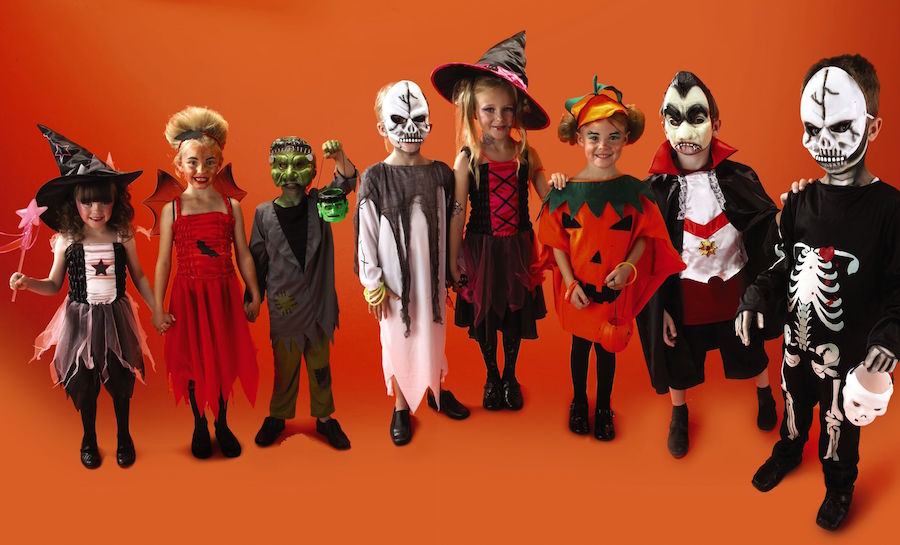It’s that spooky time of year again when everyone gets to play dress-up and devour sweet treats. Indeed, Halloween’s just around the corner, and nearly half of all Americans plan to get freaky with their celebrations this year.

According to the National Retail Federation’s annual Halloween Consumer Spending Survey, Americans will spend slightly less on holiday costs in 2015. The average person will shell out $74.34 — down from $77.52 in 2014 — on garb, candy and decorations, among other Halloween-related expenses. Total spending is expected to reach $6.9 billion in 2015, about $500 million less than in the previous year.
The biggest expense will come from costumes, as 68 million Americans are expected to dress up. But that’s not the scariest part. Another 20 million pet owners also plan to dress their pets in costume, so beware the creepy animals you might encounter in public. You don’t want to end up in a real American Horror Story.

In the spirit of Halloween, WalletHub crunched the numbers to find the cities that promise the most hauntingly good time but won’t frighten your wallet. WalletHub compared the 100 largest U.S. cities across 16 key metrics, ranging from the number of costume stores per capita to the average cost of a Halloween party ticket to the best and worst weather forecasts for Halloween. You can find the results, a detailed methodology and expert commentary below.
From our partners:
Ask the Experts
Halloween is more than just a fun holiday. It’s also a big holiday expense for many American households. WalletHub asked a panel of experts to share their financial wisdom and strategies for parents and local governments to ensure the safety and health of young trick-or-treaters this year. See the experts’ thoughts on the following key questions:
1. How can the process of collecting and allocating Halloween candy be used to teach children about personal finance?
2. What are some strategies for celebrating Halloween without breaking the bank?
3. What are the biggest Halloween money-wasters?
4. What measures should parents take to ensure their kids are safe when trick-or-treating?
5. What measures should local authorities take to ensure kids are safe when trick-or-treating?
6. What are some healthy treats or nontraditional goodies that kids might actually enjoy?

How can the process of collecting and allocating Halloween candy be used to teach children about personal finance?
There’s nothing like a bag of Halloween candy to help kids learn about finance. Candy is like any other commodity – we want something, we treasure it, we save it, and if we don’t like it, we might trade it for something else.
What are some strategies for celebrating Halloween without breaking the bank?
Often, the best costumes are homemade and foster a child’s creativity, imagination, and sense of humor. They get more attention than the store-bought ones and can lead to fun family memories, as well. Also, venues like malls and roller skating rinks often have Halloween parties where you can have a fun, low cost celebration and get candy, too.
What are the biggest Halloween money-wasters?
Packaged costumes of brand name movie characters are likely to be overpriced and will be obsolete next year. Buy something timeless that could be passed on to a younger sibling or friend in the neighbourhood. This will also teach your child about sharing, giving, and the value of special items.
What measures should parents take to ensure their kids are safe when trick-or-treating?
An adult should be walking with kids at all times. Bring a flashlight and fully charged cell phone, travel in small groups, and stick together! There should be no candy eating until you get home. Kids can relax and have fun when they know there is an adult in charge, monitoring their safety.
What are some healthy treats or nontraditional goodies that kids might actually enjoy?
Parents don’t have to go overboard with chocolate and sugar on Halloween. Sometimes, the collecting and bartering of candy is more fun than the eating. It’s okay for kids to have small portions of candy on Halloween; moderation and saving are always good policies to practice.

How can the process of collecting and allocating Halloween candy be used to teach children about personal finance?
Halloween can be a perfect time to discuss money management with your kids. Children of any age can learn basic economic principles such as the concepts of: choice and supply and demand. With Halloween, there can be numerous pieces of candy to choose. Helping them learn this concept can forge a discussion on the choices that they make every day. Also, you can talk about supply and demand with the number and amount of candy they have. Even bartering among siblings can offer great money management lessons. Another strategy for young children is simply learning how to count and sort into groups. For older kids, have them take the groups of candy that they created and make graphs. This can be done on paper or visually, with the candy sorted after the kids receive it. This is not only educational but also can be fun.
What are some strategies for celebrating Halloween without breaking the bank?
There is no getting around it – Halloween can be expensive! One of the biggest expense items around Halloween is the costumes! Instead of buying a store bought costume (which I am sometimes guilty of), make a costume with your kids. Not only can this be fun but it allows your child to get creative by using items they already have or by purchasing low cost items to put their own unique spin on their costume. If you can’t create your own, check out thrift stores or free swapping sites in your local community.
Candy can be another expensive item. One strategy to save is to purchase candy in bulk to get it at a cheaper discount. Watch for coupons or discounts at your local stores.
If you don’t want to give out candy, try giving low cost items that you can buy in bulk that kids may need and/or use i.e., pencils. Also, instead of bringing in treats for school, make home-made crafts to give out to school friends. Again – this can be fun – and allow children to be creative at the same time!
What are the biggest Halloween money-wasters?
Candy and costumes can be a huge money-waster! Most of these costumes are only worn one time. Borrowing costumes with friends, visiting thrift stores, or swapping on free bartering sites in your local community can be great money savers for you and your family.

What measures should parents take to ensure their kids are safe when trick-or-treating?
Halloween is indeed a dangerous holiday, mainly because we send tens of millions of kids out into the dark. They get hit by cars, they get tangled up in their costumes, fall, and injure themselves, etc. There are lots of lists of safety tips that are mostly good advice: make sure the children’s costumes do not obscure their vision; make share they can walk without stepping on the costume; don’t let them carry open flames; etc. I just question whether the warnings about inspecting all the treats are necessary.
Methodology
In order to find the most spook-tacular destinations for Halloween celebrants, WalletHub compared 100 of the most populated U.S. cities across three key dimensions: 1) Safety & Surroundings, 2) Parties & Activities and 3) Halloween Weather. For the sample, WalletHub chose each city according to the size of its population. Please note that “city” refers to city proper and excludes surrounding metro areas.
To obtain the final rankings, WalletHub attributed a score between 0 and 100 to each metric, then calculated the weighted sum of the scores and used the overall result to rank the cities. Together, the points attributed to the three major dimensions add up to 100 points.
Safety & Surroundings – Total Points: 60
- Percentage of the Population Age 14 or Younger (used as a proxy for the number of potential trick-or-treaters): Double Weight (~16 Points.
- Percentage of Occupied Housing Units (used as a proxy for all potential stops for trick-or-treaters): Half Weight (~4 Points)
- Population Density: Full Weight (~8 Points)
- Walk Score (measures walkable distance in the neighborhood): Full Weight (~8 Points.
- Crime Rate (neighborhood security): Double Weight (~16 Points)
- Pedestrian-Fatality Rate: Full Weight (~8 Points)
Parties & Activities – Total Points: 30
- Average Price of a Halloween Party Ticket: Full Weight (~4.62 Points)
Note: Averages are based on Halloween events listed on Eventbrite.com as of Oct. 22, 2015, where at least two events were available.
- Number of Halloween Costume Stores per 100,000 Residents: Full Weight (~4.62 Points)
- Number of Candy Stores per 100,000 Residents: Full Weight (~4.62 Points)
- Number of Movie Theaters per 100,000 Residents (for horror films timed with Halloween): Half Weight (~2.31 Points)
- Average Movie Ticket Price: Half Weight (~2.31 Points)
- Number of Bars per 100,000 Residents: Full Weight (~4.62 Points)
- Number of Amusement Parks: Full Weight (~4.62 Points)
- Acres of Land Under Pumpkin Harvest: Half Weight (~2.31 Points)
Halloween Weather – Total Points: 10
- Difference Between the Average Forecasted Temperature for Halloween & the Average
- Normal Temperature for This Time Period: Full Weight (~5 Points)
- Forecasted Precipitation for Halloween: Full Weight (~5 Points)
Sources: Data used to create these rankings were obtained from the U.S. Census Bureau, the Federal Bureau of Investigation, the Council for Community and Economic Research, the National Agricultural Statistics Service, AccuWeather, WalkScore, Yelp, Smart Growth America and Eventbrite.
This feature is written by Richie Bernardo and originally appeared in WalletHub.


















